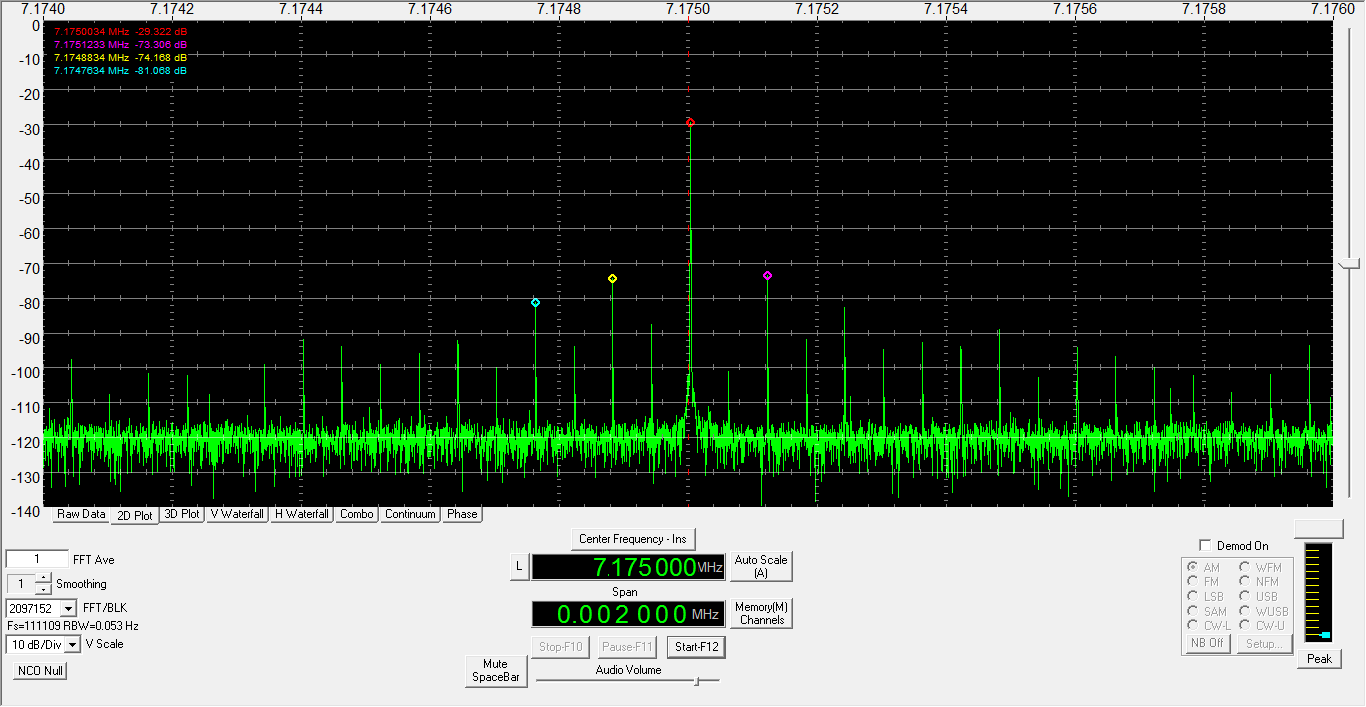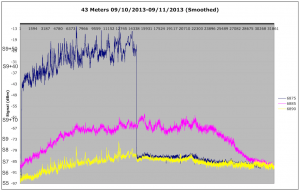Music at sign on today 11/17/13 1700z 15245kHz
Into YL/OM.
Noisy here with approaching t-storms/tornados
Only broadcasts Tues, Thurs, Sat & Sun best I can tell.
Language tigrinya – via Sophia, Bulgaria
Hope you like the recording of the 1st 90 secs (aborted by thunder claps in distance).
A simple and inexpensive frequency generator for homebrew transmitters, the Cypress CY22150
Virtually all homebrew transmitters are crystal controlled. This is excellent from a stability point of view, but creates the difficulty of having to obtain the crystals. Usually this involves hunting around hamfests and swapmeets, hoping you’ll find a crystal of a suitable frequency. This can be hit or miss, especially for “out of band” operation, like 43 meters, where it is more miss than hit.
I’ve done some experimentation with building my own Phase Locked Loop frequency generators, but the results were always dismal. I recently came across the CY22150 Programmable Clock Generator from Cypress. This single IC implements the PLL, divider circuits, and everything else. You just need a crystal for the reference (there’s a built in oscillator). And the crystal can be virtually any frequency.
First, you may wish to look at the CY22150 Datasheet
The CY22150 is in a TSSOP-16 SMD package, which is not very hobbyist friendly. I bought some of these adapters from eBay, which make the task of prototyping much easier. The CY22150 itself is available from Mouser and is $2.55 in single quantities.
The CY22150 uses an I2C serial interface to configure the various settings. For my experiments, I connected it to a Raspberry Pi single board computer. You could bit bang the I2C commands out the parallel port of a computer as well, if you wished. The CY22150 can also be programmed using Cypress supplied software, so no I2C interfacing is required. I have not tried this, but it could be useful in cases where operation on only one frequency is required.
I soldered the CY22150 onto the PCB, and attached it to the Raspberry Pi, which also provided the 3.3 volt power:
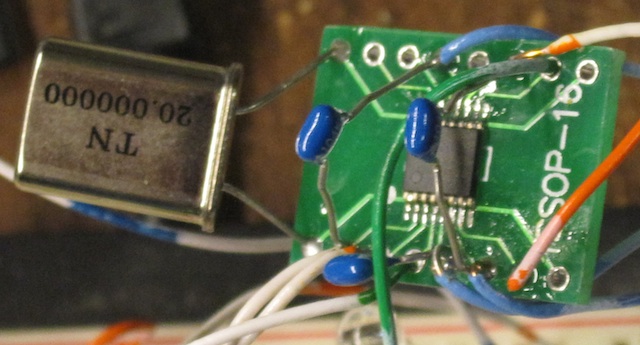
Several registers in the CY22150 control the PLL, and set the output frequency. You have to compute three divider ratios. There are also several other settings, and I’ll go through them below:
First, after powering everything up, you need to enable one of the outputs. In my case, I am using Clock Output 1, so I need to set register 09H to a value of 01H.
Second, I need to specify the source of this output. The datasheet refers to this as the “Crosspoint switch matrix control”, and the end result is setting register 44H to 20H, which tells the chip that we want the output to be DIV1CLK divided by DIV1N.
Third, we need to set the chip to use the internal oscillator with a crystal. In my case, a 20 MHz crystal. We need to set the oscillator gain level, based on the crystal frequency. Referring to the datasheet, we need the gain bits to be 10, and the end result is register 12H is set to a value of 30H. I played around with these values, and did not find them to be critical.
Fourth, we need to set the input load capacitor control. These are equivalent to the small (10 pF or so) capacitors you connect to the crystal in an oscillator circuit. What nice here is that we don’t need any external capacitors, they are built into the chip, and we can select the values to use! Register 13H sets the capacitor value. And, we can adjust their value to move the oscillating frequency, so we can get it dead on. In my case, for a 20 MHz crystal, I needed to set register 13H to 8F.
Here is the 20 MHz oscillator output signal, looking at XOUT pin of the CY22150:
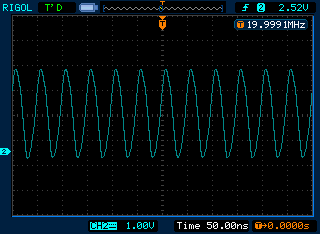
I finally get to use the screen capture mode of my Rigol scope!
Now it gets a little hairy. We need to compute the divider ratios. The datasheet shows you how to do this. I found some source code on the net that calculates the values for you, as an iterative process. There are multiple divider ratios to produce a given output frequency, the code finds the best set and smallest frequency error.
First, here is the C source code:
int main(int argc, char **argv)
{
double f_ref;
double f_out;
if (argc != 3)
{
fprintf(stderr, "usage: cy22150 refFreqkHz outFreqkHz\n");
exit(1);
}
f_ref = atof(argv[1]);
f_out = atof(argv[2]);
fprintf(stderr, "f_ref %g kHz\n",f_ref);
fprintf(stderr, "f_out %g kHz\n",f_out);
f_ref = 1000.0*f_ref;
f_out = 1000.0*f_out;
fprintf(stderr, "f_ref %g Hz\n",f_ref);
fprintf(stderr, "f_out %g Hz\n",f_out);
double q_min = 2;
double q_max = (int)(f_ref / 250000.0);
double d_min = (int)(1.0 + 100000000.0 / f_out);
double d_max = (int)(1.0 + 400000000.0 / f_out) - 1.0;
double f_test, f_diff;
double f_track = f_out;
double p_test, q_test, d_test;
int p, q, d;
for (q_test = q_min; q_test <= q_max; q_test++)
{
for (d_test = d_max; d_test >= d_min; d_test--)
{
p_test = (f_out / f_ref) * q_test * d_test;
p_test = ((p_test - (int)p_test) > .5) ? (int)(p_test + 1.0) : (int)p_test;
f_test = (f_ref * p_test) / (q_test * d_test);
f_diff = ((f_test - f_out) > 0.0) ? (f_test - f_out) : (f_out - f_test);
if (f_diff < f_track)
{
f_track = f_diff;
p = (int)p_test;
q = (int)q_test;
d = (int)d_test;
fprintf(stderr, "p:%d ",p);
fprintf(stderr, "q:%d ",q);
fprintf(stderr, "d:%d ",d);
fprintf(stderr, "f_test:%g ",f_test*0.001);
fprintf(stderr, "f_diff:%g \n",f_diff*0.001);
}
}
}
exit(0);
}
Running it for 7175 kHz produces the following output:
$ ./cy22150 20000 7175
f_ref 20000 kHz
f_out 7175 kHz
f_ref 2e+07 Hz
f_out 7.175e+06 Hz
p:39 q:2 d:55 f_test:7090.91 f_diff:84.0909
p:39 q:2 d:54 f_test:7222.22 f_diff:47.2222
p:38 q:2 d:53 f_test:7169.81 f_diff:5.18868
p:33 q:2 d:46 f_test:7173.91 f_diff:1.08696
p:113 q:7 d:45 f_test:7174.6 f_diff:0.396825
p:221 q:14 d:44 f_test:7175.32 f_diff:0.324675
p:287 q:16 d:50 f_test:7175 f_diff:0
You call the program, passing it the frequency of your crystal, and the desired output frequency. It then goes through a few steps, and finds the best match.
The divider ratios are p, q, and d. In this case, they are 287, 16, and 50 respectively. These need to be set in several registers in the CY22150:
Ptotal (p) is the most confusing. We actually have to calculate what the datasheet refers to as PB and PO. The formula is P total = 2*(PB+4) + PO. In our case, we have 287=2*(PB+4) + PO. So PO is 1. Then we solve 286=2*(PB+4): 143=PB+4, or PB=139. That's 8BH.
PB goes into registers 40H and 41H. The high two bits go into 40H. You also need to write three charge pump control bits into 40H, and set the two high bits of 40H. In our case, the two high bits of PB are zero. So we just need to set the two high bits and the charge pump bits. From the datasheet, we want to write C4H. We also need to write the low bit into register 0CH when we set the D divider ratio, below. The 8BH value we calculated above goes into register 41H.
D goes into register 0CH. 50 decimal is 32 hex so we write 32H.
Q goes into register 42H. PO goes into the high bit. You actually have to write Q-2 into the register, so we need to write 14 decimal, which is 0EH. Plus since PO is 1, we set the high bit, so we end up writing 8EH.
Whew!
We ended up with these register settings:
09: 01 Enable output 1
0c: 32 D = 50
12: 20 Xtal drive
13: 8f Load capacitor set for accurate 20 mhz
40: c4 Set two high bits, bits 2,3,4 are charge pump, 4 is the correct value based on P
41: 8b PB=139
42: 8e Q of 16, so we set to 16-2=14, set high bit because PO (low bit) of P counter is 1
44: 20 Set the output to be DIV1CLK / DIV1N
For fun, you can also compute the divider ratios for say 6925 kHz:
p:277 q:16 d:50 f_test:6925 f_diff:0
Note that these values are based on a 20 MHz crystal. If you use a different value, they will be different. But that's the great thing about this chip, you can use whatever you have!
Here is the scope looking at the CLOCK 1 output :
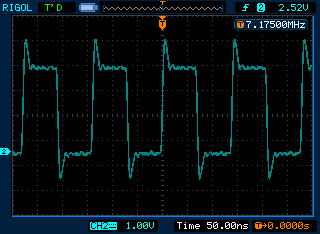
And here is what it looked like on an SDR-14:
As you can see, I do have a 60 Hz pickup issue to solve. No doubt due to the rats nest of wires. But... it works!
Since the Raspberry Pie may be overkill for many homebrew transmitter applications, another possibility, besides programming the Cy22150, would be to use a inexpensive microcontroller such as a PIC to send the I2C commands to the chip. I may look into this as a future project.
Radio Ye Mehr
Caught 10/11/13 1630z Friday
15680kHz 1630 sign on
Iranian clandestine in Farsi
Tough copy not helped by Audacity acting up.
You get the idea….
Voice of the Forums of Eritreans
Logged todat 10/19/13 Saturday.
15245kHz 1700 sign on with music.
Chanting at close for last few minutes.
In opening recording sign on is at about +30 secs so be patient please.
Hope that you enjoy.
If you think there’s been more pirate activity during the shutdown, you’re right!
Here’s a graph showing the number of unique pirate logging threads on the HFUnderground.com
Each thread represents a different shortwave pirate radio broadcast. The red bars on the right are the number of broadcasts during the shutdown per day. I’ve also drawn in green the average number of broadcasts per day during the month before the shutdown (6.9 per day) as well as during the shutdown (12.2). As you can see, activity is up 77%. This past weekend was extremely active, setting records.
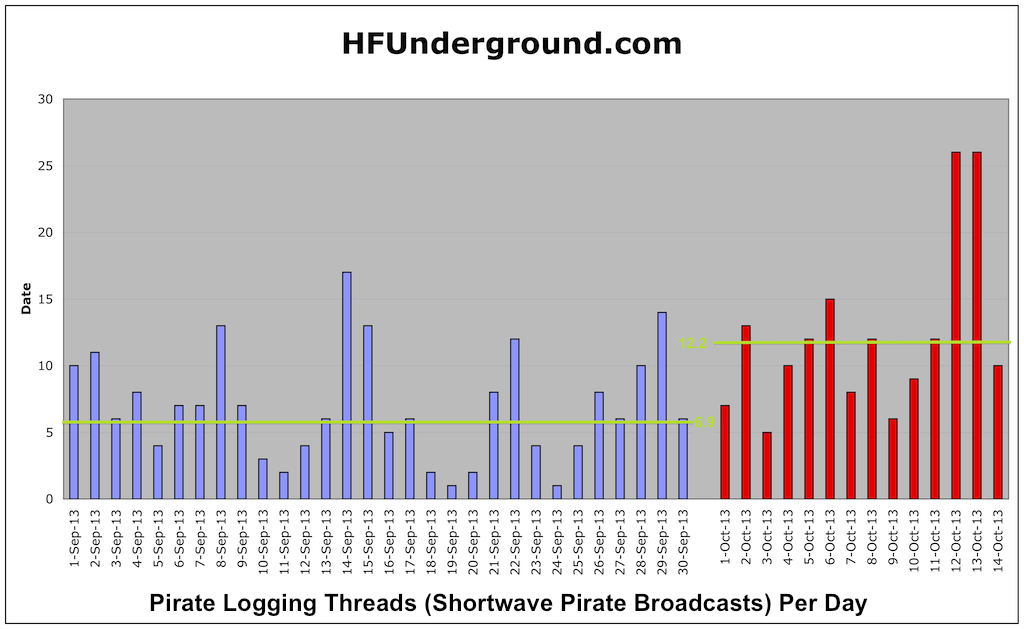
Pirate Station YHWH
There’s a relatively new religious pirate station, apparently from the west coast as that’s where most of the loggings have been from. The programming consists mostly of readings from the Old Testament, as well as religious commentary. YHWH being Yahweh without the vowels.
First reported on 5990 kHz on September 7, 2013, starting at 0220 UTC. Then on 6010 kHz on September 11, 2013 from 0440-0502 UTC, and then on 6010 kHz on September 15, 2013 from 0120 until 0204 sign off, all by Dan Sheedy of Encinitas, CA.
Bob LaRose of San Diego, CA heard YHWH on 9775 kHz on September 28, 2013 until 0133 UTC.
Glenn Hauser of OK heard them on October 8, 2013 on 9775 kHz starting at 0105 UTC, and heard past 0145 UTC.
Most recently, YHWH was heard on October 14, 2013 on 3234.95 kHz by Ron Howard of CA, who provided an audio recording of the ID.
Thanks to Glenn Hauser of DX Listening Digest for the above logs.
However, it looks like YHWH has been heard since at least August. I found this logging from W6SO of Woodland Hills, CA :
Is anyone else hearing a broadcaster (Station YHWH) in the 80 M band (3.845 Mhz using AM)? It is currently 18 August 2013 at about 04:15 GMT and this station has been there for over an hour now. Is this station in some way legitimate, or are they just bootlegging in the middle of our bands?
W7UUU in Tacoma, WA also heard that transmission.
Our own Pigmeat Martin heard YHWH on October 7, 2013 on 9775 kHz at around 2330 UTC (I suspect this was the UTC October 8 logging), so it is making it to the east coast.
There was some speculation that YHWH transmitted on the Sabbath (Friday night, UTC Saturday if from the west coast), but here’s a list of the reported transmissions:
3845 August 18, 2013: Sunday
5990 September 7, 2013: Saturday
6010 September 11, 2013: Wednesday
6010 September 15, 2013: Sunday
9775 October 8, 2013: Tuesday
3235 October 14, 2013: Monday
I’m not sure how well 6 MHz will propagate to the east coast at 0100 UTC, that is 6 PM local time on the west coast. 3 MHz is even more doubtful. 9 MHz should have the best chance.
If anyone knows of any loggings of YHWH lot listed above, please let me know, either via an email, comment to this blog post, or via a post to the HF Underground.
Some more updates: Token has heard this station as far back as May 18, 2013 on 6925 kHz at 0145 UTC. Also on July 27, 2013 at 0115 on 6950 kHz. The following weekend he heard YHWH just above the 40 meter ham band.
Radio Inyabutatu 9/28/13
Caught 9/28/13 at 1700z sign on. Conditions noisy but listenable. Here’s the 1st few minutes of the broadcast from the sign on.
Hope you enjoy,
fpeconsultant
Radio Voice of Hope 2/10/01
For old times sake. Recorded 2/10/01 0426z 12060kHz. One of my all time favorites with the bone drum open into an English ID by YL back to the bones. Nothing on parallel 15320kHz. Sudan clandestine.
I hope that you like it as much as I do.
Radio Inyabutatu
Thanks to Glimmer Twin I copied this clandestine today 9/21/13 at 1700z on 17870kHz,
As luck would have it my Audacity froze for a few seconds just as they signed on with unknown music – the recording has a quick burst of the music into an OM in an unknown language.
Assumed from Sophia, Bulgaria to Rwanda (which is clearly mentioned a few times
How Signal Strengths Vary on 43 Meters Over Time
The follow graph is the signal strength on three frequencies, from 2055 UTC on 10 September 2013 to 0545 UTC on 11 September 2013:
(Click on the image to see a larger version)
The X axis scale at the top of the graph is seconds since the recording started (2055 UTC)
The Y axis scale is the signal strength in dBm. I’ve marked off several corresponding S meter readings for easy comparison.
I’ve smoothed out the signal readings with a low pass filter, to make the general trends easier to see.
6875 kHz is used by WWCR, which you can see signed on at 2100 UTC, and signed off at 0100 UTC. It has a transmitter power of 100 kW, and is located approximately 700 miles to my southwest.
6885 kHz is used by Galei Zahal, Israeli army radio, which has a power of 5 kW. It is approximately 5800 miles away.
6890 kHz had no station, and was recorded to show how the background noise levels varied.
Local sunset here was 2322 UTC, which is at about 9300 on the X axis.
Several things can be observed:
The signal strength of both WWCR and Galei Zahal steadily increased until local sunset. This is likely due to the D layer of the ionosphere recombining, which means it causes less attenuation to the radio signals.
Likewise, the background noise level also increased over this time period, from about S5 to a little over S7.
You can also observe Galei Zahal fade out as the Sun began to rise in Israel.
WWCR had a strong signal, but there was considerable variability, about 3 S units worth.
WWCR is within the range of where you expect to find most pirate stations in the Northeast USA (Guise Faux’s famous 500 miles around Pittsburgh). We can extrapolate how strong it would be at lower power levels, in the range most pirates use. We can also take into account the high gain provided by their antennas, as their characteristics are provided at the FCC. They claim 14 dB. I’ll assume that I am likely in their main beam.
The signal level of WWCR is about -25 dBm during the peak signal period. Adjusting for the antenna gain, we can reduce it to -39 dBm.
We can further adjust for the power level. If instead of 100 kW it was 100 watts, we would expect the signal to be about 30 dB less (a power factor of 1000 is equal to 30 dB), So that would be -69 dBm, just a bit above S9, which is -73 dBm.
At 30 watts, we’d expect 5 dB less, or -74 dBm, very close to S9.
At 10 watts, our standard grenade power level, we’d expect a signal of -79 dBm, which is close to S8.
These signal levels seem reasonable, based on signal levels I have observed, when the operator gave their transmitter power.
Observe from the graph that the background noise levels were about S7 during the time period. So a 10 watt signal would be about an S unit above noise, or barely audible at this distance, 700 miles. At 30 watts, you’d be about 2 S units above noise, and somewhat easier to hear. 100 watts would be almost 3 S units above noise.
For fun, we can do the same with the Galei Zahal transmitter power. I know nothing about their antenna setup, so we can’t compensate for that. Their signal was about – 67 dBm, once it got dark. Reducing the 5 kW transmitter power to 100 watts reduces the signal by 17 dB, or down to -84 dBm, which is S7. So it would be barely audible. Europirates in the 100 watt range are heard well here, but that part of Europe is much closer, so that’s to be expected.
Much of the background noise is static from thunderstorms. Once we get into late fall and winter, storm activity levels are much less, and the noise level should go down.

